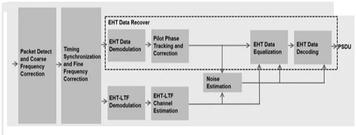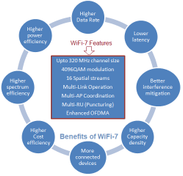Adjacent and Nonadjacent Channel Rejection in WiFi-7 (802.11be)
Advertisement
Wi-Fi 7 (IEEE 802.11be) introduces enhanced capabilities to improve the performance of wireless communications, including stringent requirements for adjacent and nonadjacent channel rejection. These parameters are crucial for ensuring that Wi-Fi 7 devices can operate effectively in environments with many overlapping and closely spaced channels, such as dense urban settings or areas with multiple access points.
Adjacent and nonadjacent channel rejection are measures of a receiver’s ability to filter out unwanted signals from nearby channels, allowing it to focus on the desired signal even in the presence of interference from neighboring channels.

Image Courtesy: Rohde & Schwarz
Key Points of Adjacent and Nonadjacent Channel Rejection
1. Adjacent Channel Rejection (ACR)
-
Definition: Adjacent channel rejection is the ability of the receiver to suppress signals from channels that are directly next to the channel of interest. It measures the receiver’s tolerance to interference from an adjacent channel and is defined by how much stronger the adjacent channel signal can be relative to the desired signal while maintaining acceptable performance.
-
Requirement: A higher ACR value indicates better rejection capability. In Wi-Fi 7, the ACR requirement is typically defined by a minimum level of rejection (in dB) at which the receiver can maintain a specified performance, such as a Packet Error Rate (PER) of 10%.
-
Typical Values: For Wi-Fi 7, the ACR might be specified as:
- For 20 MHz channels: Around 35 dB.
- For wider channels, such as 160 MHz or 320 MHz: The rejection requirements might be slightly lower due to increased bandwidth and potential cross-channel interference.
2. Nonadjacent Channel Rejection (NCR)
- Definition: Nonadjacent channel rejection measures the receiver’s ability to suppress signals from channels that are not directly adjacent but still within the same band. This includes channels that are separated by one or more unused channels.
- Requirement: NCR measures how well the receiver can reject interference from nonadjacent channels while still decoding the desired signal accurately. Similar to ACR, NCR is specified by a minimum rejection level (in dB).
- Typical Values: For Wi-Fi 7, NCR values are generally higher than ACR, often around 45 dB or more, reflecting the expectation that nonadjacent interference is less challenging than adjacent interference.
3. Importance of Rejection Performance
- Minimizing Interference: Strong adjacent and nonadjacent channel rejection helps reduce interference, allowing the receiver to filter out unwanted signals and focus on the desired signal. This is particularly important in high-density environments where many devices operate in close proximity.
- Improving Throughput and Reliability: Effective channel rejection directly improves the throughput and reliability of Wi-Fi 7 devices, as it reduces the chance of errors caused by nearby transmissions.
4. Testing and Compliance
- Test Procedures: During testing, a signal at the desired frequency is transmitted alongside a stronger interfering signal on an adjacent or nonadjacent channel. The power of the interfering signal is increased until the receiver’s performance degrades beyond acceptable limits (e.g., PER > 10%).
- Measurement: The difference in power levels between the desired signal and the interfering signal at which performance starts to degrade is recorded as the rejection level.
| MCS | Modulation | Coding Rate (R) | Adjacent Channel Rejection (in dB) | Nonadjacent Channel Rejection (in dB) |
|---|---|---|---|---|
| 0 | BPSK | 1/2 | 16 | 32 |
| 1 | QPSK | 1/2 | 13 | 29 |
| 2 | QPSK | 3/4 | 11 | 27 |
| 3 | 16QAM | 1/2 | 8 | 24 |
| 4 | 16QAM | 3/4 | 4 | 20 |
| 5 | 64QAM | 2/3 | 0 | 16 |
| 6 | 64QAM | 3/4 | -1 | 15 |
| 7 | 64QAM | 5/6 | -2 | 14 |
| 8 | 256QAM | 3/4 | -7 | 9 |
| 9 | 256QAM | 5/6 | -9 | 7 |
| 10 | 1024QAM | 3/4 | -12 | 4 |
| 11 | 1024QAM | 5/6 | -14 | 2 |
| 12 | 4096QAM | 3/4 | -17 | -1 |
| 13 | 4096QAM | 5/6 | -20 | -4 |
| 14 | BPSK-DCM-DUP | 1/2 | 16 | 32 |
| 15 | BPSK-DCM | 1/2 | 16 | 32 |
Example of Rejection Requirements
For a 20 MHz Wi-Fi 7 receiver:
- Adjacent Channel Rejection: The receiver may need to reject signals at an adjacent channel that is 35 dB stronger than the desired signal.
- Nonadjacent Channel Rejection: The requirement may increase to 45 dB, as nonadjacent channels are expected to have a reduced impact on the desired signal due to greater frequency separation.
In environments such as offices, stadiums, or residential complexes where many Wi-Fi networks coexist, strong adjacent and nonadjacent channel rejection is critical to avoid cross-network interference. Wi-Fi 7 devices often operate alongside legacy devices (Wi-Fi 6/6E, Wi-Fi 5), making robust rejection capabilities essential to coexist and maintain performance across different generations of Wi-Fi.
Summary
In summary, adjacent and nonadjacent channel rejection in Wi-Fi 7 as defined by IEEE 802.11be are crucial specifications that enhance the receiver’s ability to filter out interference from nearby channels. This capability is essential for maintaining high data rates, low error rates, and reliable communication in complex and dense wireless environments.
Advertisement
 RF
RF


